We use some tools in the book Red Chip Poker to help with the math away from the table. Using these tools after a session will help tune your intuition for when you are playing in real-time. Here are some recommended concepts and tools that will help in understanding our book, and poker in general.
Combos, Combinations, Combinatorics…they all mean the same thing. They mean we are looking at hands from a mathematical point of view and counting the ways our opponent can make certain hands. If you are totally new to the concept you should start with this video from ThePokerBank.com:
Starting from preflop, we know that a player can have: six combos of any pocket pair, four combos of any suited hand, twelve combos of any unsuited hand, and sixteen combos of any unpaired hand (which includes both the suited and unsuited combos). This is very simple and a basic building block of understanding preflop combinations. Next we can look at blockers and how those influence the equation. Say for instance we have A♦7♦ and we are trying to figure out how many combinations of AK our opponent can have. Well because we have the A♦ it’s impossible for our opponent to have A♦K♦ since there is only ONE A♦ in the entire deck. Similarly, our opponent cannot have A♦K♠, A♦K♥, A♦K♣ either. Due to our A♦ blocker we know our opponent’s possible AK combos have been reduced from 16 down to 12. We can also use the concept of combos postflop. For instance, assume the flop is:
A♠ Q♠ 8♥
We know that there are:
- 6 combos of an non-set pocket pair like 22
- 3 combos of any set like 88 (8♣8♠, 8♣8♦, 8♠8♦)
- 12 combos of any AK (3 unseen Aces * 4 unseen Kings)
- 9 combos of any two pair (3 unseen Aces * 3 unseen Queens)
We can also use the concept of blockers postflop. For instance, because the As is on the board it is impossible for someone to have A♠ K♠. If someone would only have AQ suited in their preflop range then they can only have 3 combos of top two pair (A♦Q♦, A♣Q♣, A♥Q♥). If you need some extra material on this concept check out this video:
In this book we discuss combos and blockers to hand read and calculate the EV of various lines. These concepts may seem a little technical at first, but with some practice they will become second nature and help you become a great hand reader.
Expected Value (EV)
EV, short for expected value, is the mathematical way of saying “this play is expected to net me $X in the longrun.” If you are not comfortable with EV formulas yet watch this video so that the formula EV = (%W*$W)-(%L*$L) is no longer petrifying.
Equity Calculators
We use equity calculations quite often when analyzing hands away from the table. This allows us to more accurately gauge the correctness of our lines, as well as develop intuition when estimating equities in real-time. If you do not already have an equity calculator we suggest this free calculator from PokerStrategy.com. You can learn how to use this software with this free video from ThePokerBank.com made by SplitSuit
We always start by entering either hands or ranges and then simply evaluating their equities. You can enter a single hand by going here: 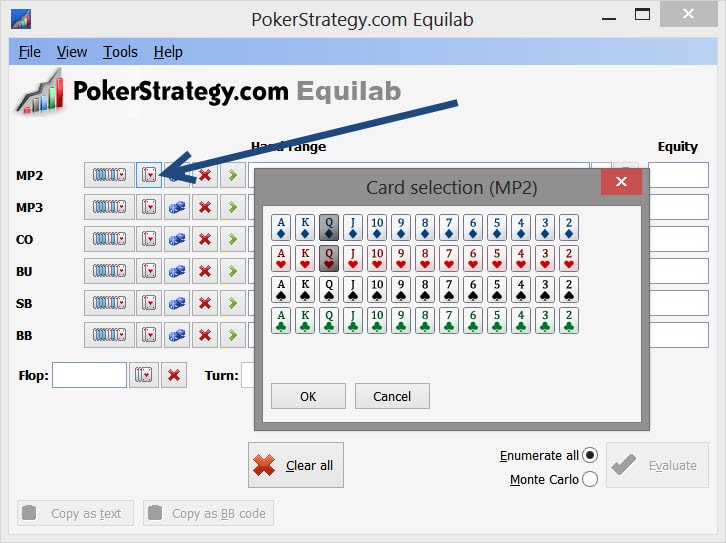 Or you can enter a range by going here:
Or you can enter a range by going here: 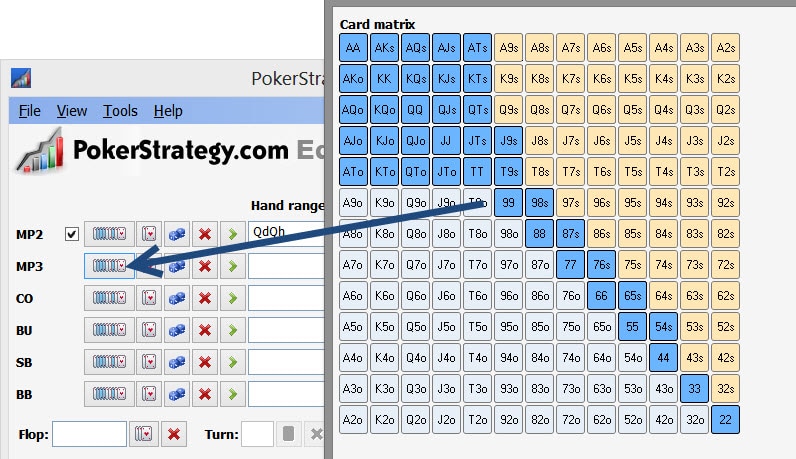 If there are multiple players involved you can always enter their hole cards or ranges as well by repeating this process. Once you have all the hands/ranges input just click “Evaluate” to see their respective equities.
If there are multiple players involved you can always enter their hole cards or ranges as well by repeating this process. Once you have all the hands/ranges input just click “Evaluate” to see their respective equities. 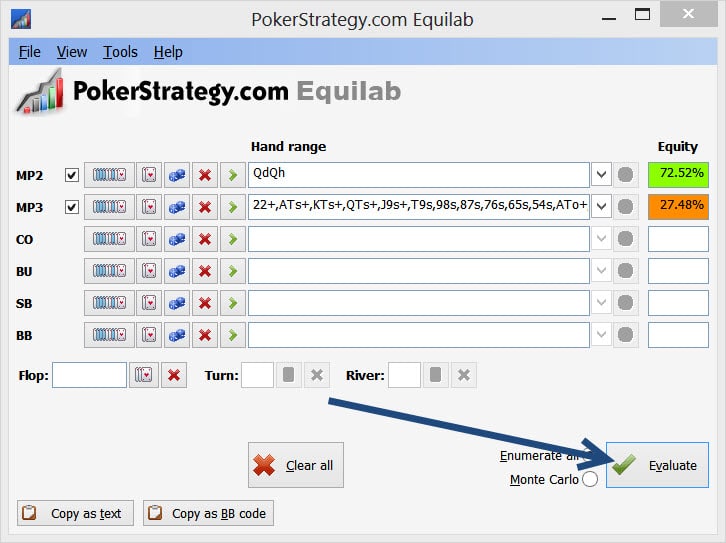 You can also enter Flop, Turn, and River cards if the hand went postflop. To do this just go here:
You can also enter Flop, Turn, and River cards if the hand went postflop. To do this just go here: 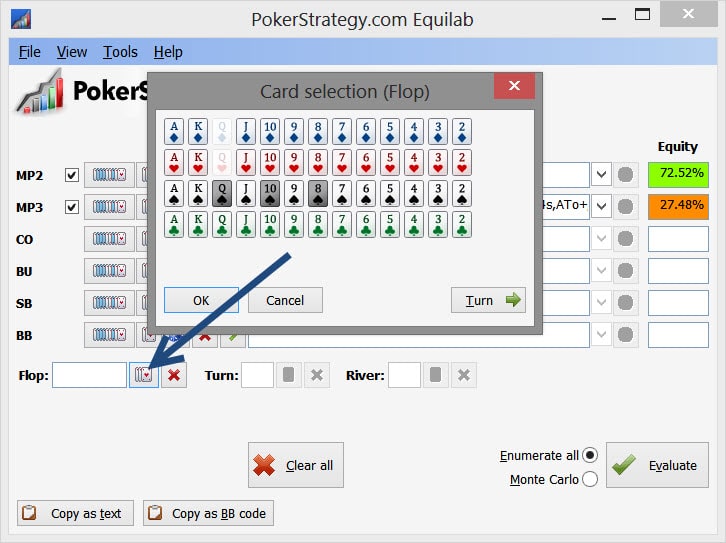 Then make sure to click Evaluate again to update the equities with the new information.
Then make sure to click Evaluate again to update the equities with the new information. 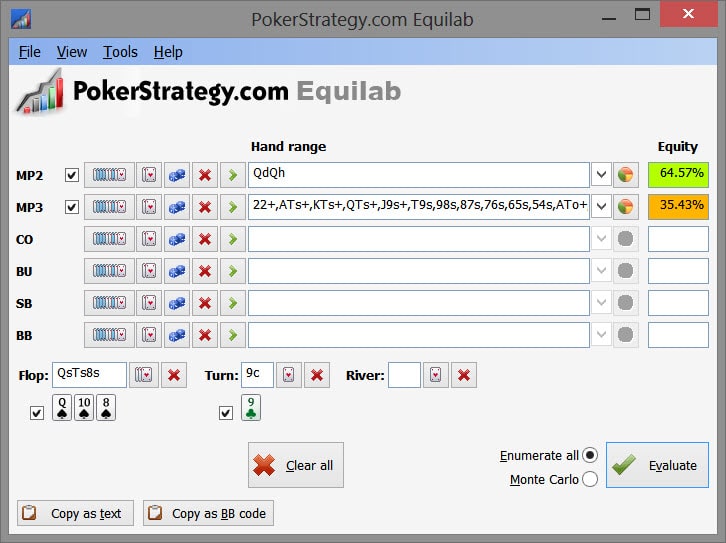 There are lots of equity calculations in the book that we use to find the best lines. Estimating your opponent’s range of hands to input into an equity calculator can be tricky, but with practice and experience you will get better at hand reading. The only bad news is that you will not have time to use an equity calculator at the table, but enough off-table practice will allow you to more accurately guess your hand’s equity and thus take better mathematical lines.
There are lots of equity calculations in the book that we use to find the best lines. Estimating your opponent’s range of hands to input into an equity calculator can be tricky, but with practice and experience you will get better at hand reading. The only bad news is that you will not have time to use an equity calculator at the table, but enough off-table practice will allow you to more accurately guess your hand’s equity and thus take better mathematical lines.
Fold Equity Calculators
There are many times in this book when we use a Fold Equity Calculator to estimate how many folds we need to make a +EV shove. We love this tool so much that we created a free fold equity calculator that you can use too! Here is a quick video showing you how to use it:
To use this tool we just need four pieces of information:
- The effective stack size
- The estimated equity of our hand
- The current pot size
- The size of any bet or raise we are facing
The effective stack size is how much we are risking when shoving. We can figure out estimated equity using an equity calculator. The current pot size is how much money is in the middle before we shove. And we also fill in the size of any bet or raise if applicable. So if we take an example where the pot is $80 and we are planning to open-shove a pure bluff with zero equity for $50, we can fill everything in like this: 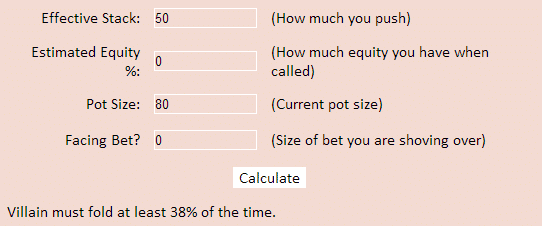 This tells us that villain needs to fold at least 38% of the time for this to be 0EV, or breakeven. So if our opponent would fold more than 38% of the time it would be a +EV shove, and if he would fold less than 38% of the time it would be a -EV shove.
This tells us that villain needs to fold at least 38% of the time for this to be 0EV, or breakeven. So if our opponent would fold more than 38% of the time it would be a +EV shove, and if he would fold less than 38% of the time it would be a -EV shove.  Just like equity calculations we do not have the time to use them at the table, but enough practice with them off the table will help us understand inflection points more easily.
Just like equity calculations we do not have the time to use them at the table, but enough practice with them off the table will help us understand inflection points more easily.
Flopzilla
Flopzilla is an excellent tool used for understanding how ranges hit boards. You can also explore combinations, range strengths, and how certain hole cards hit flops. This video from ThePokerBank.com gives you a free in-depth introduction to this powerful piece of software.
Hand Reading
Everything we do in poker is based upon our opponent’s range. Good hand reading skills will allow you to pick off bluffs, properly estimate your equities, and play better both preflop and postflop. This video shows you the “3 L’s Of Hand Reading” to give you a framework for putting players on a better range of hands.

I really appreciate this. Im a member of other sites and this kind of info is very helpful
Thanks Keone! If you have any suggestions for future articles, feel free to drop them in our forum thread: https://redchippoker.com/forum/viewtopic.php?f=5&t=26
I want to get Flopzilla. It now costs 35$ on their site, but I think SplitSuit once said in one of his videos that you could get it for 20$ if you confirmed that you know Flopzilla through him. On the other hand, I can’t find it. Is it out of date?
Unfortunately that offer is no longer available. That being said, you get a copy of Flopzilla included in the price of my new course: The Hand Reading Lab
Hi I am a player and feel I am an expert at 6maxnlh and wanted to know do you guys have a lot of math savvy videos that are advanced for busing card runner ev and other math calculations away from the table?
Hi Johnny. We do have some very mathy videos, including the “Constructing Ranges” series by Doug Hull. Grab a free trial and check them out =)